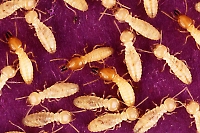By any other name it's a "German Cockroach".
This pesky critter got its name as a household pest in 1890 when water from the "Croton Resevoir" began augmenting New York cities municipal water supply.
(919) 971-9143
(919) 557-9019
Dampwood termites (Termopsidae) constitute a small and rather primitive family of termites (Isoptera). They contain a mere 4-5 extant genera with 13-20 living species, but can be divided into several subfamilies. They may be a nuisance but compared to e.g. the drywood termites (Kalotermitidae) usually do not cause extensive damage to buildings or other man-made structures. As their name implies, they like to eat wood that is not dried out, perhaps even rotting, and consequently of little use to humans.
The termites as a group were traditionally placed in the Exopterygota, but such an indiscriminate treatment makes that group a paraphyletic grade of basal neopterans. Thus, the termites and their closest relatives like the cockroaches relatives are nowadays separated in a clade called Dictyoptera. The dampwood termites are sometimes included with the harvester termites (Hodotermitidae) but this is not followed by the majority of authors and indeed the two families seem to represent distinct lineages which both merely retain some similar plesiomorphies and are generally among the more basal Isoptera.
Unsurprisingly, two of the subfamilies usually placed in the Termopsidae are monotypic. The other one contains 3 living genera. However, Stolotermes is somewhat aberrant and its placement in the Termopsidae is in need of scrutiny; current understanding suggests that it might be better considered considerably closer to the most advanced termites such as Rhinotermitidae and Termitidae; perhaps it would better be placed with these, perhaps it even deserves to be treated as a family on its own like Serritermes.
The termites are a group of eusocial insects usually classified at the taxonomic rank of order Isoptera (but see also taxonomy below). Along with ants and some bees and wasps which are all placed in the separate order Hymenoptera, termites divide labour among gender lines, produce overlapping generations and take care of young collectively. Termites mostly feed on dead plant material, generally in the form of wood, leaf litter, soil, or animal dung, and about 10% of the estimated 4,000 species (about 2,600 taxonomically known) are economically significant as pests that can cause serious structural damage to buildings, crops or plantation forests. Termites are major detritivores, particularly in the subtropical and tropical regions, and their recycling of wood and other plant matter is of considerable ecological importance.
As eusocial insects, termites live in colonies that, at maturity, number from several hundred to several million individuals. Colonies use a decentralised, self-organised systems of activity guided by swarm intelligence to exploit food sources and environments that could not be available to any single insect acting alone. A typical colony contains nymphs (semi-mature young), workers, soldiers, and reproductive individuals of both genders, sometimes containing several egg-laying queens.
Termites are sometimes called "white ants", though they are not closely related to true ants.

Rhinotermitidae is a family of termites (Isoptera). They feed on wood and can cause extensive damage to buildings or other wooden structures. About 345 species are recognized, among these are severe pests like Coptotermes formosanus and Reticulitermes flavipes.
